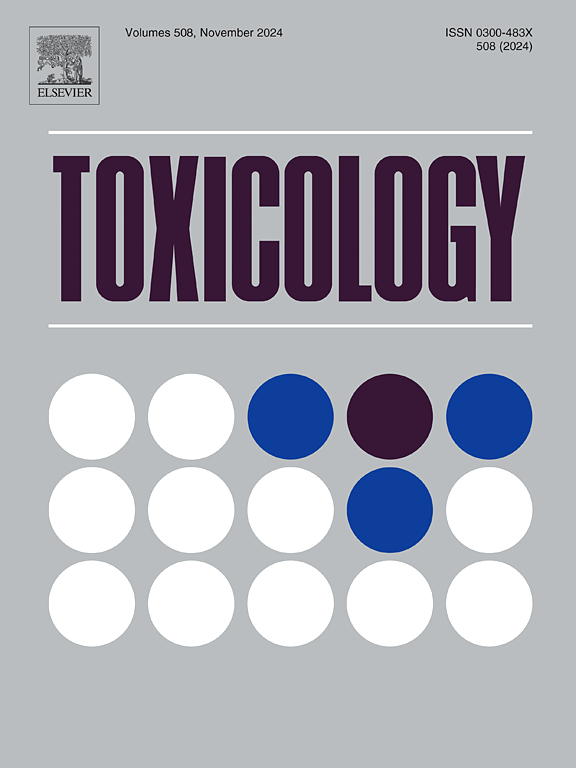Inhalation of dust accumulated on personal computer fans in the office may cause pathological effects by disrupting the metabolic activity of alveolar macrophages
IF 4.6
3区 医学
Q1 PHARMACOLOGY & PHARMACY
引用次数: 0
Abstract
Considering that computer fans draw in dust from the office air, and that printers and copiers are typically placed near computers, we collected dust that accumulated on computer fans from three commercial personal computer centers to predict the health effects of inhaled office dust (OD). OD contained various types of microplastics and non-protein particles, and several hydrophilic elements were bound to the OD. When aspirated OD via the pharynx for 90 days, blood levels of IP and K significantly decreased in male mice, but not in female mice. Meanwhile, the total number of pulmonary cells increased, accompanied by increases in the proportions of lymphocytes and PMNs, as well as pulmonary levels of pro-inflammatory and anti-inflammatory mediators. Foamy alveolar macrophages and mucous cell hyperplasia were observed in the lung tissues, accompanied by increased levels of TGF-β1, IL-11, and IL-24. More importantly, structural disruption of mitochondria, mitophagy, and the formation of lamellar bodies and collagen fibers were frequently observed in the lung and heart tissues of OD-treated mice. In addition, LDH release and ATP production were not significantly affected in OD-treated alveolar macrophage cells, even at the highest concentration. Meanwhile, very interestingly, the activity of the NADPH-dependent cellular oxidoreductase enzyme decreased dramatically, even at the lowest concentration. Genes related to cytokine-cytokine receptor interaction and neutrophil extracellular trap formation were most significantly affected in cells exposed to OD, and Saa3, Cybb, Slc7a11, and CXCL2 were identified as the most upregulated genes. The expression of SOD-2, FeH, and COX-2 proteins was enhanced in OD-treated cells, along with increased NO production, whereas the expression of transferrin receptor and BAX protein was reduced in the same cells. Collectively, we suggest that OD exposure may increase the lung burden of foreign bodies by disrupting the metabolic activity of alveolar macrophages, ultimately resulting in chronic pulmonary diseases. We also hypothesize that impaired self-renewal capacity may contribute to the lung burden of OD.
吸入积聚在办公室个人电脑风扇上的灰尘,可能会扰乱肺泡巨噬细胞的代谢活动,从而引起病理作用。
考虑到电脑风扇从办公室空气中吸收灰尘,打印机和复印机通常放在电脑附近,我们从三个商业个人电脑中心收集了积聚在电脑风扇上的灰尘,以预测吸入办公室灰尘(OD)对健康的影响。OD中含有各种类型的微塑料和非蛋白颗粒,并结合了几种亲水性元素。经咽吸OD 90天后,雄性小鼠血液中IP和K水平显著降低,而雌性小鼠则无明显下降。同时,肺细胞总数增加,淋巴细胞和pmn比例增加,肺促炎和抗炎介质水平升高。肺组织可见泡沫状肺泡巨噬细胞及黏液细胞增生,TGF-β1、IL-11、IL-24水平升高。更重要的是,在od处理小鼠的肺和心脏组织中,线粒体的结构破坏、线粒体自噬、板层体和胶原纤维的形成频繁出现。此外,即使在最高浓度下,od处理的肺泡巨噬细胞的LDH释放和ATP产生也未受到显著影响。同时,非常有趣的是,即使在最低浓度下,nadph依赖性细胞氧化还原酶的活性也急剧下降。在暴露于OD的细胞中,与细胞因子-细胞因子受体相互作用和中性粒细胞胞外陷阱形成相关的基因受到的影响最为显著,其中Saa3、Cybb、Slc7a11和CXCL2被鉴定为上调最多的基因。SOD-2、FeH和COX-2蛋白的表达在od处理的细胞中增强,并增加NO的产生,而转铁蛋白受体和BAX蛋白的表达在相同的细胞中降低。综上所述,我们认为OD暴露可能通过破坏肺泡巨噬细胞的代谢活动来增加异物的肺负担,最终导致慢性肺部疾病。我们还假设自我更新能力受损可能会导致肺负荷过度。
本文章由计算机程序翻译,如有差异,请以英文原文为准。
求助全文
约1分钟内获得全文
求助全文
来源期刊

Toxicology
医学-毒理学
CiteScore
7.80
自引率
4.40%
发文量
222
审稿时长
23 days
期刊介绍:
Toxicology is an international, peer-reviewed journal that publishes only the highest quality original scientific research and critical reviews describing hypothesis-based investigations into mechanisms of toxicity associated with exposures to xenobiotic chemicals, particularly as it relates to human health. In this respect "mechanisms" is defined on both the macro (e.g. physiological, biological, kinetic, species, sex, etc.) and molecular (genomic, transcriptomic, metabolic, etc.) scale. Emphasis is placed on findings that identify novel hazards and that can be extrapolated to exposures and mechanisms that are relevant to estimating human risk. Toxicology also publishes brief communications, personal commentaries and opinion articles, as well as concise expert reviews on contemporary topics. All research and review articles published in Toxicology are subject to rigorous peer review. Authors are asked to contact the Editor-in-Chief prior to submitting review articles or commentaries for consideration for publication in Toxicology.
 求助内容:
求助内容: 应助结果提醒方式:
应助结果提醒方式:


